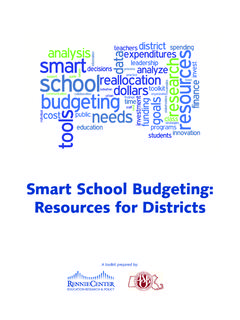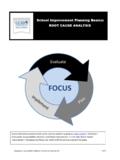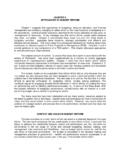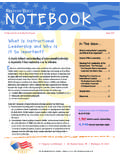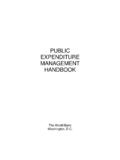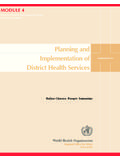Transcription of Smart School Budgeting: Resources for Districts
1 Smart School budgeting : Resources for Districts A toolkit prepared by: Table of Contents Section 1: 1. The state of School 2. Why local budget analysis is 3. Section 2: Setting 4. Transparency and communication about resource 5. Section 3: Types of 6. Table : Popular School 6. Site-based 8. Student-based budgets / Weighted student 9. Section 4: Strategies for analyzing current spending .. 10. Formulas to analyze current budget 10. Budget analysis in 11. Evidence for reallocation 12. Research on spending in 13. Section 5: Tools for budget 14. Table : Tools for budget 14. Section 6: Cost saving 17. Contracting 17. Examples of cost saving 18. Table : Examples of cost saving 18.
2 Appendix A: 20. Appendix B: References in topic 20. Appendix C: References in alphabetical 25. Appendix D: MASBO 29. 30. Rennie Center FOR EDUCATION RESEARCH & POLICY ii Section 1: Introduction In an era of aggressive public education reform, it is important to ask not only whether new initiatives are effective in raising student achievement, but also how they can best maximize current investments in teaching and learning. While School Districts ideally should use comprehensive information systems to develop data-driven budgets that link School spending to desired educational outcomes, examples of this practice are rare. Instead, School budget models have been mostly constructed piece- meal over decades to meet the increasing demands, and conflicting priorities, of the modern education system.
3 What is needed is a more strategic and deliberative approach to School budgeting , as well as tools and Resources to help challenged Districts make more efficient and effective spending decisions. The goal of this document is to serve as a user-friendly summary of existing Resources on School finance, budgeting , and real- location. What is offered is not specific guidance on how to spend money or on which programs to fund. Evidence on most educational practices remains uncertain, particularly with regard to how resource allocation shapes outcomes, and research into School finance indicates that School budgeting may be most effective when decisions are locally determined and attentive to School and community needs.
4 Rather, this document is intended to push School leaders to take a more deliberative approach to School budgeting that includes: setting goals; analyzing spending patterns; building consensus on an effective approach;. choosing the right budget model; and tracking costs. The toolkit directs School business officials and district leaders to practi- cal and useful information to help shape resource decisions. Each section includes an overview of each topic, summaries of the most useful documents and Resources , relevant case studies (if available), and a resource list with hyperlinked documents for easy The toolkit is organized in this way: Section 1: Introduction: An overview of the toolkit.
5 The state of School budgets: What education budgets look like today. Why local budget analysis is needed: Spending and outcomes are not linked; what local leaders can do. Section 2: Setting goals: Creating a strategy for resource allocation in your district . Transparency and communication about resource allocation: Tips for communication about budget decisions. Section 3: Types of budgets: Discussion of budget models available for School Districts . Table : Notable School budgets: Table outlining education budget models, including pros and cons of using each. Site-based budgets: Decentralized budget model at the School level. Student-based budgets / Weighted student funding: Distributing Resources based on individual student needs.
6 Section 4: Strategies for analyzing current spending: Research on resource reallocation. Formulas to analyze current budget allocations: Ways to analyze current budget allocations. Budget analysis in practice: Using budget analysis research to understand district spending. Evidence for reallocation strategies: Discussion of reallocation strategies based on research evidence. Research on spending in classrooms: Research findings related to spending for teachers and classrooms. Section 5: Tools for budget analysis: Tools available for Districts to analyze their own budget. Table : Tools for budget analysis: Table outlining existing tools for budget analysis.
7 Section 6: Cost saving strategies: Reducing costs in your district . Contracting services: Using outsourcing as a cost saving strategy. Table : Examples of cost saving strategies: List of potential cost saving strategies, including related Resources . Appendix A: Methodology: A description of the methodology used in creating this document. Appendix B: References in topic order: Complete list of references used to create this document, organized by topic. Appendix C: References in alphabetical order: Complete list of references in alphabetical order. Appendix D: MASBO publications: Descriptions of other notable MASBO publications. a. Note: There are many more documents or sources in each resource list than discussed in the text; these are still relevant to the topic and may prove useful.
8 Moreover, the selected documents and sources referenced in this publication are not endorsed by the Rennie Center. In some cases, the full text of a docu- ment or book is not available online; in these instances, hyperlinks lead to the most relevant location (such as an online retailer selling the book). Links to Resources are accurate as of the date of release. Rennie Center FOR EDUCATION RESEARCH & POLICY 1. The state of School budgets Resources . budgeting is the process of using information to allocate finite Resources to prioritize organizational needs. In School Districts , budgeting requires using information about Financial Accounting for Local School staff, students, and facilities to meet student learning needs and Districts and State School Systems (Ch.)
9 1). ideally should use comprehensive information systems, including financial data and National Center for Education student performance measures, to develop data-driven budgets that help ensure the Statistics effective use of Resources to support and align effective practice across programs and Funding Student Learning: educational How to Align Education Unfortunately, information systems linking School spending and student performance Resources with Student Learning Goals rarely exist, if at all. Current School finance models, especially at the local level, are National Working Group on typically not designed to support uniformly high levels of student learning, particularly Funding Student Learning when dealing with diverse student populations.
10 They were constructed incongruently Investing in Improvement: over decades to fund enrollment, build schools, support programs, hire staff, etc. What Strategy and resource exists today are funding arrangements so complex that it is difficult to use Resources Allocation in Public Schools strategically or track their Districts Childress For example, Districts are often drawn to new ideas for improving student perfor- mance and, consequently, launch new initiatives, but leave previous initiatives in place. Making Education Dollars Work: Understanding Without using data to analyze the impact of all activities, leaders may base decisions resource Allocation on fairness and reduce spending across the board.
